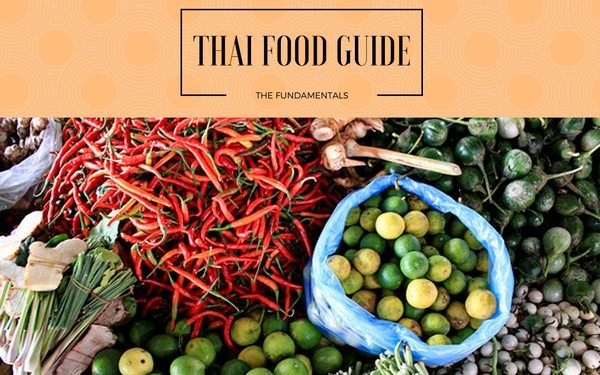Thai food is one of the most beloved cuisines on Earth.
Whether you’re in a back street of Vientiane, Midtown Manhattan or even on the Alpine slopes, you can guarantee that there’s a Thai restaurant nearby.
But despite its international popularity, the complexity of Thai cooking and wealth of ingredients to be used means that Thai food often remains just a delicious mystery to its outsiders.
And maybe you’re happy to keep it that way.
But, if you’re anything like us — absolutely rabid consumers of knowledge — you’ll want to know everything there is to know about Thai cuisine from the ground up.
Don’t worry: we’ve got you covered.
Here, we present, the fundamentals of Thai cuisine.
- Balancing the Elements
- Regional Cuisines and Influences
- Dish Categories
- Rice and Noodles
- Dipping Sauces and Pastes
- Shopping List
- Best Thai Food Blogs
Balancing the Elements
Harmony is everything in Thai food.
A successful Thai meal will strike a delicate balance between the elements of sweet, sour, salty, spicy and sometimes bitter.
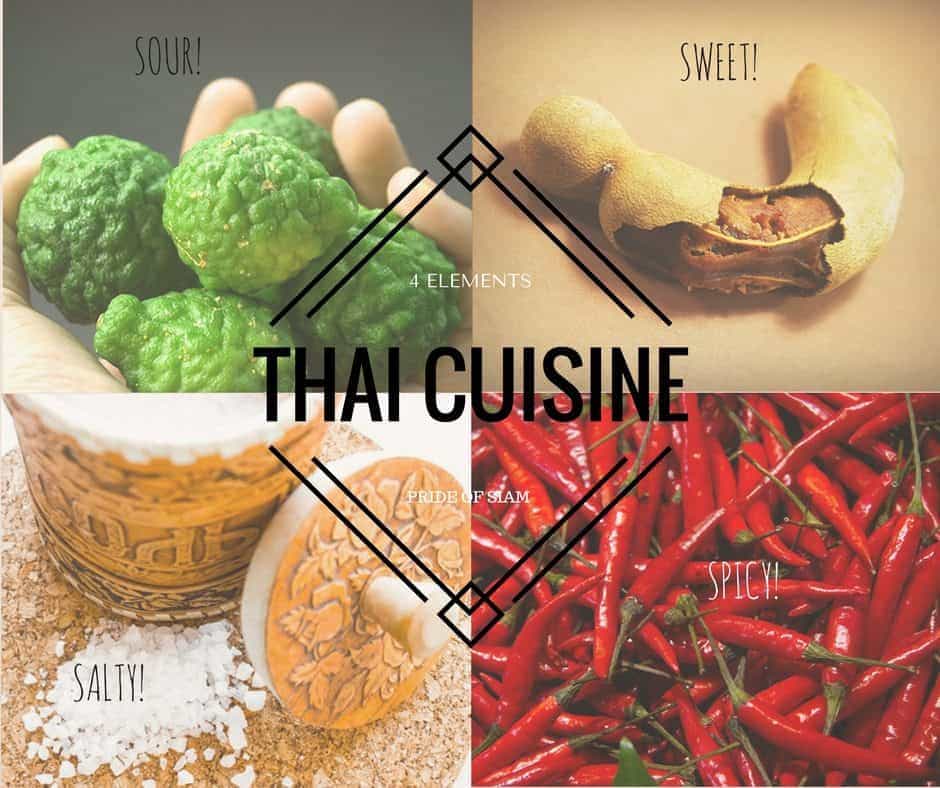
Thais eat family style — sharing between lots of individual dishes — and the harmony should extend through the aromas, tastes and aesthetics of each individual dish all the way through to the balance of the entire meal experience.
David Thompson, the Australian head chef at Nahm, told a reporter in 2010,
Thai food ain’t about simplicity. It’s about the juggling of disparate elements to create a harmonious finish. Like a complex musical chord it’s got to have a smooth surface but it doesn’t matter what’s happening underneath. Simplicity isn’t the dictum here, at all. Some westerners think it’s a jumble of flavours, but to a Thai that’s important, it’s the complexity they delight in.
If the balance is off in a dish, say if your street vendor gets a little too handsy with the palm sugar, then the magic of that dish will be destroyed.
Regional Cuisines and Influences
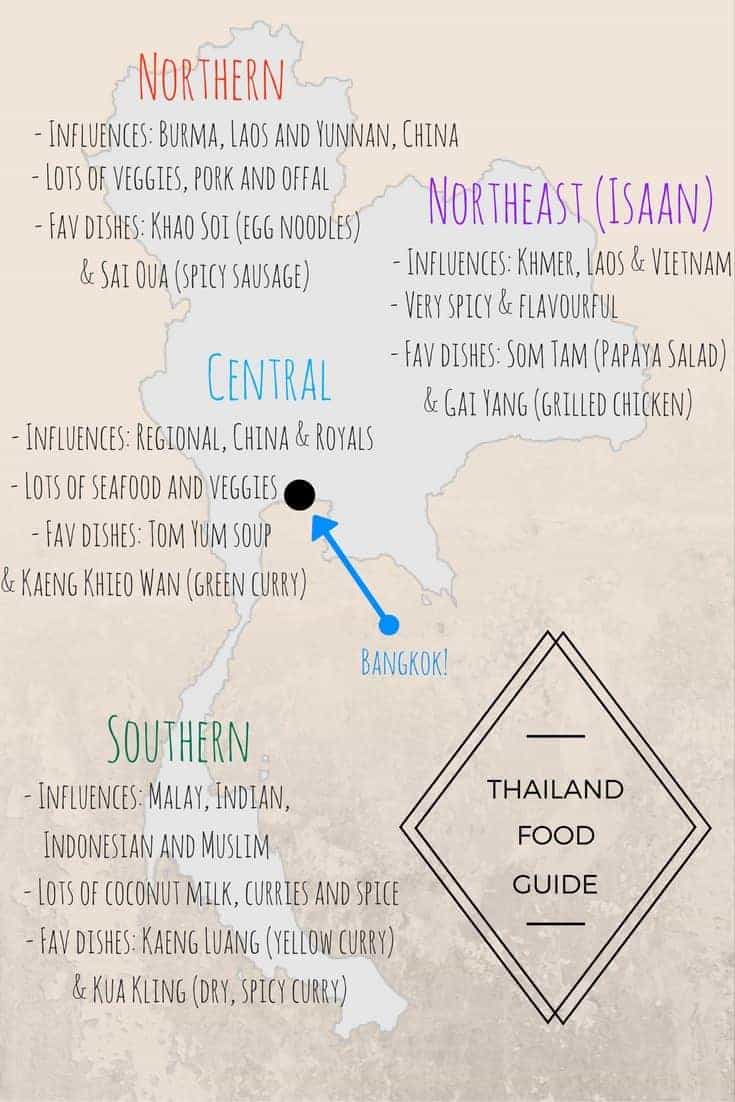
Anyone with even the mildest understanding of Thailand is aware of the huge number of ethnic groups, foreign influences and distinct regions at play in the country’s culture, politics and, of course, cuisine.
It would probably be more accurate to group all the many different regional cuisines under the umbrella of Pan-Thai cuisine, rather than looking at it as a homogenous whole.
Added to these regional trends is the fact that many individual families pass down idiosyncratic recipes through their bloodline, which inevitably means that no two Pad Thais, for instance, are the same. Variety in the details can be spotted throughout Thai cuisine.
There are 4 distinct regional cuisines within Thailand:
Northern Thailand
Up in the northern highlands, stretching across from Mae Hong Son, Chiang Mai, Lamphang, Phrae, Nan and up to Chiang Rai, the region of the former Lanna Kingdom enjoys a cuisine heavily influenced by neighbouring Myanmar, Northern Laos and Yunnan, China.
Favourite Northern dishes include Khao Soi — an egg noodle dish — spicy Northern sausage and noodle dishes, including Khanom Jeen and Kuay Tiaw.
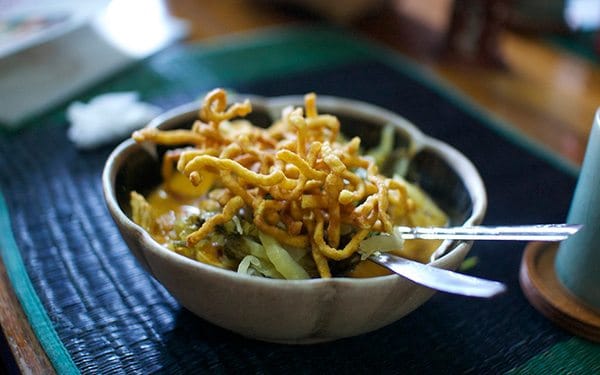
Khao Soi noodles (By chezshai: Creative Commons)
A colder climate up here in the mountains allows for a wider variety of vegetables to be grown and harvested so dishes are typically veggie heavy. When it comes to meat, pork and offal are well represented.
Northeastern Thailand
The Northeast of Thailand, also known as Isaan, is famous for its incredibly flavourful and spicy dishes, including salads and sauces. As this has traditionally been one of the poorest regions of Thailand, thanks to the arid Khorat Plateau not being an optimal environment for rice farming, local cooks were forced to make the more expensive meats and salad dishes as flavourful as possible so people would be encouraged to eat more of the cheaper rice in a bid to soak up those flavours.
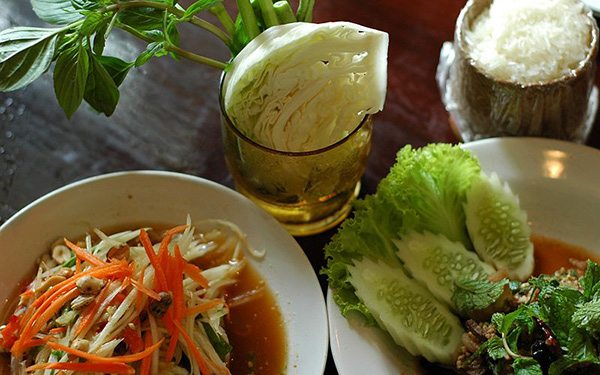
An Isaan feast (By User: (WT-shared) Jpatokal at wts wikivoyage: Creative Commons)
Isaan cuisine is heavily influenced by Khmer culture from Cambodia, Southern Laos, and Vietnam.
Favourite Isaan dishes include Som Tam (spicy salad), Jim Jum (hot pot), sticky rice, Gai Yang (grilled chicken), Larb Moo (minced pork salad), Nam Tok Moo (grilled pork salad) and Tom Saap (hot and sour soup).
Central Thailand
In contrast to Isaan, Central Thailand is one of the richer regions of the country thanks to the flat, wet and fertile plains perfect for rice growing, and being the site of several ancient kingdoms, including Sukothai, Ayutthaya, Thonburi and now, of course, Bangkok. Vegetables and seafood are abundant in central cuisine.
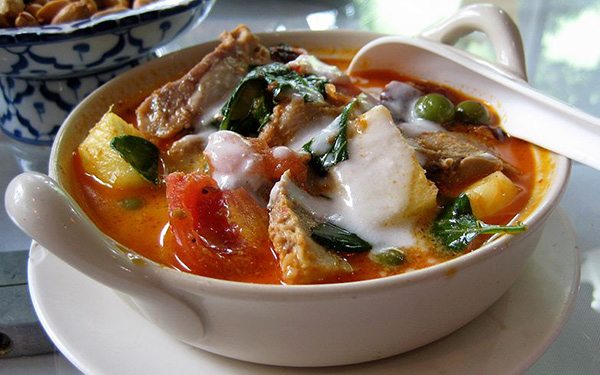
A curry from the Central region, influenced by the Ayutthaya palace cuisine (By Terence Ong: Creative Commons)
Although much of the Central cuisine brings in influences from all over the country, they also have a few distinct ones of their own, including Chinese and palace-style cooking.
Favourite Central dishes include the famous Tom Yum soup, Jasmine rice, Kaeng Khieo Wan (green curry) and pla phao (roasted fish).
Southern Thailand
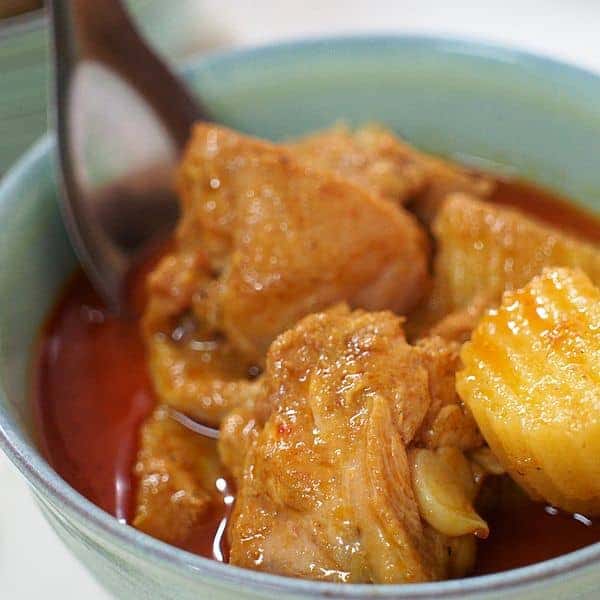
Massaman curry (By Takeaway: Creative Commons)
Travelling to the South of Thailand can sometimes feel like you’re in a different country as the local culture is so separate from the more northern provinces. Malay, Indian, Indonesian and general Muslim influence is keenly felt in Southern cuisine, with much emphasis on curries and spice.
Coconut milk and cream play a large role in many dishes here, thanks to the plethora of palm trees and coconut plantations. Unsurprisingly, given its location straddling both the Andaman Sea and Gulf of Thailand, seafood is abundant in the south and is widespread in dishes here.
Southern food is also known for being incredibly spicy so watch out!
Favourite dishes include Kaeng Luang (Yellow curry), Kua Kling (spicy, dry curry) and Khao Yam (rice salad).
Dish Categories
Most Thai dishes can be easily grouped into a certain category, with variation between dishes seen in the details: what type of rice or noodles is used, for instance, the flavour of the broth, type of meat, accompanying sauce, etc.
Rice Dishes
Rice is often referred to as the backbone of Thai cuisine so it should be no surprise that there are an plethora of such dishes in Thai cuisine. It’s usually accompanied by meat in some configuration or another, plus a broth or sauce.
Popular rice dishes:
- Khao Mun Gai (poached or steamed chicken, chicken broth and rice cooked slowly in the chicken fat)
- Khao Pad (fried rice)
- Khao Pad Kaprow (spicy, basil fried rice with chicken or pork)
- Congee (rice pudding)
Fried Noodle Dishes
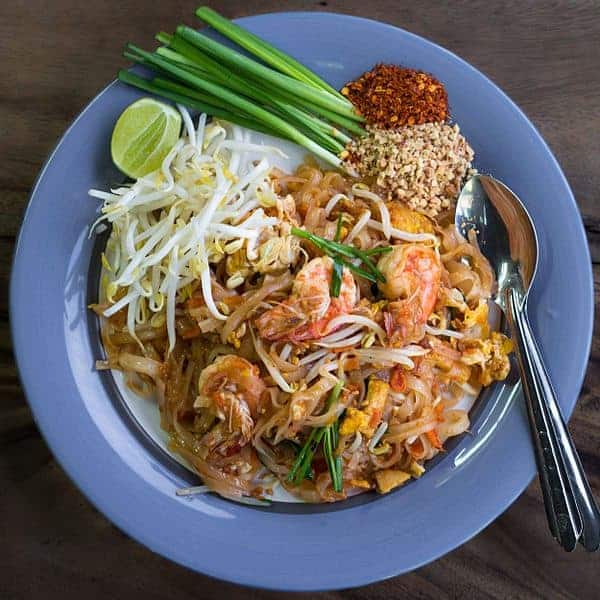
Pad Thai (By Takeaway: Creative Commons)
Thais love their noodles and fried with a mix of meats and vegetables is the ideal one-dish lunch for many. There are an absolute bounty of difference types of noodle, which we’ll look at shortly.
Popular fried noodle dishes:
- Khanom Jeen (fermented rice noodle served with curries and spicy sauces)
- Pad Thai (rice noodles fried with egg, chicken, prawns, tofu and tamarind — one of Thailand’s most famous exports)
- Pad See Ew (rice noodles fried with soy sauce, meat and greens)
- Kuai Tiao Pad Kee Mao (the famous Drunken Noodles — spicy rice noodles fried with soy sauce, meat and vegetables)
- Pad Wun Sen (glass noodles stir fried with meat or seafood)
Noodle Soup Dishes
Noodles in soup is also a super popular Thai dish, often seen being served up by street vendors for the lunchtime and dinner crowd, and originally brought to Thailand from China many moons ago. The dish varies according to the type of noodles used, the broth added and meat used.
Popular noodle soup dishes:
- Bamee (egg noodle soup, often served with roast pork or duck)
- Khao Soi (crispy fried egg noodles served in curry)
- Kuai Tiao Ruea (boat noodles: rice noodles served in a meat broth with beef or pork plus offal and blood)
Salads
Thai salads are probably not like any you’ve had before: imagine vegetables and meat combined with sweet, sour, salty and spicy flavours. Yam (salads) are especially popular in Isaan cuisine.
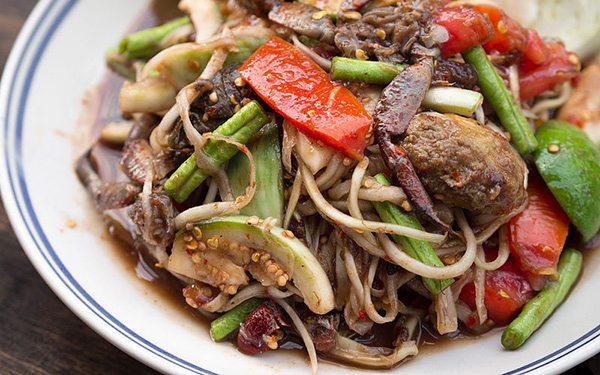
Spicy beef salad (By Takeaway: Creative Commons)
Popular Thai salad dishes:
- Som Tam (green shredded papaya salad served with peanuts and dried shrimp. Other variations serve it with salted eggs or pla ra — fermented fish)
- Laab (minced meat served spicy and sour with shallots, lime juice and chilli)
- Nam Tok Moo (spicy pork salad)
- Yam Nua Yang (spicy grilled beef salad)
- Yam Pla Duk Fu (crispy catfish salad)
Curries
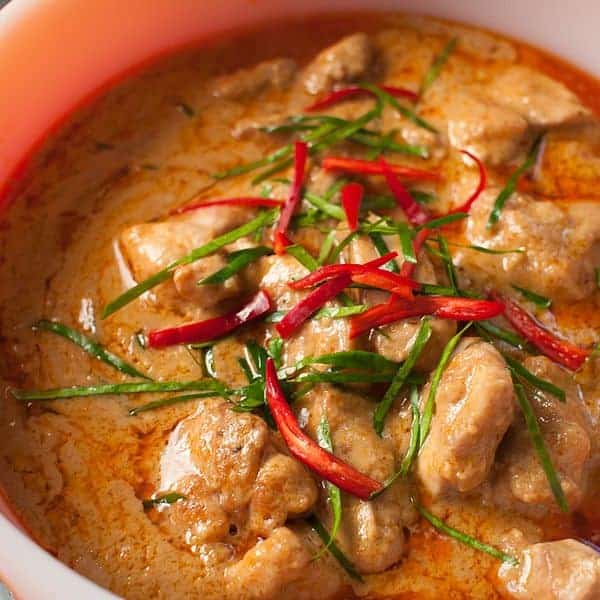
Red curry (By Takeaway: Creative Commons)
Each regional cuisine in Thailand sports their own versions of curry, all made with curry paste, fresh herbs and aromatic leaves. The paste is usually combined with either water or coconut milk (the latter is particularly prevalent in the South).
Popular Thai curries:
- Kaeng Khieo Wan (green curry made with coconut, chilli, holy basil and chicken)
- Kaeng Luang (yellow curry, sour and spicy, made with turmeric, fish and vegetables)
- Kaeng Massaman (a thick, mild curry made with coconut milk and stewed chicken or beef)
- Kaeng phet (spicy red curry with coconut milk and dried chillis, meat and vegetables)
Soups
Incredibly flavourful, often spicy, soups are one of the most famous components of Thai cuisine. Aromatic and nourishing, no Thai meal eaten family style is complete with a big steaming bowl of soup to dip your spoons and sticky rice in.
Popular soup dishes:
- Tom Khao Gai (chicken, galangal and coconut milk; spice levels vary)
- Tom Sap (spicy and sour, made with stewed meats, lime juice and fresh herbs)
- Tom Yum (spicy and sour broth with galangal, kaffir lime and lemongrass with prawns and chicken)
Vegetable dishes
Vegetarianism isn’t exactly widespread in Thailand but the Thais sure do love their vegetables. They can be found in the majority of dishes, from curries to soups, but are also the main focus of various stand-alone dishes too.
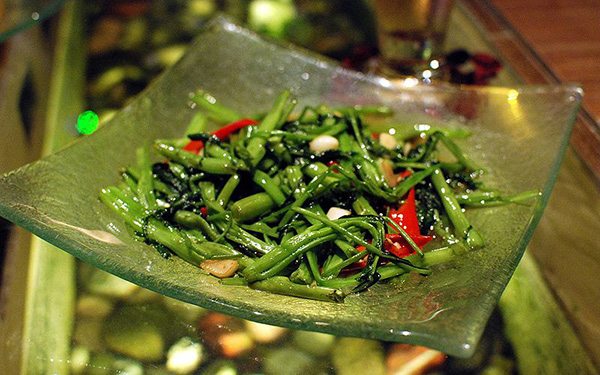
Stir-fried morning glory (By Takeaway: Creative Commons)
Popular veggie dishes:
- Phak Bung Fai Daeng (fried morning glory)
- Phak Khana Nam Man Hoi (stir fried Chinese kale in oyster sauce)
- Pad Phak Ruam (sit fried vegetables in oyster sauce)
Stand-Alone Meat & Fish Dishes
Thai cuisine also has plenty of dishes where the focus is solely on the meat, and any rice or noodles can be ordered separately to accompany the dish.
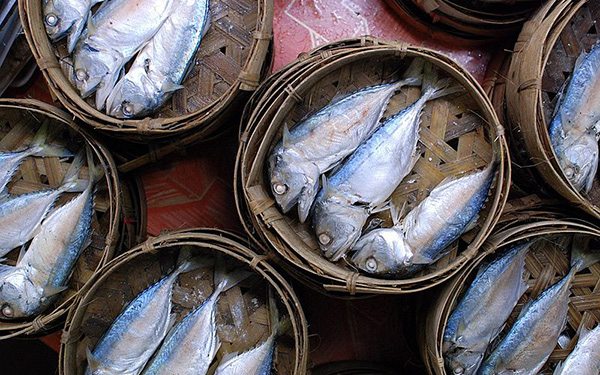
Pla Tu (By Takeaway: Creative Commons)
Popular meat dishes and snacks:
- Gai Ho Bai Toei (deep fried chicken wrapped in Pandan leaves)
- Khaep Moo (pork crackling)
- Pla Thot (deep fried fish)
- Gai Yang (grilled chicken)
- Sai Krok Isaan (spicy Isaan pork sausage)
- Hoy Tod (oyster omelette)
Desserts
If you thought that there was more than enough sugar in savoury Thai cuisine for us to forgo dessert, then you are very much mistaken. Thai people love their sweet treats and these can be found across restaurants, street carts, and ready to take home in luxury shopping malls.
Popular desserts:
- Khao Niew Mamuang (mango with sticky rice and coconut milk)
- Roti (flat breads topped with banana, nutella or condensed milk)
- Khanom Bueand (crispy mini pancakes)
- Bamee Wan (egg noodles with syrup and shaved ice)
Rice and Noodles
The variety doesn’t stop at meat and vegetables when it comes to Thai cuisine: there are also an array of different noodle configurations to choose from and a few rice options too.
Types of Thai rice
- Sticky rice (glutinous rice, easy to roll into a ball to mop up sauces and curries with)
- Jasmine rice/Thai Hom Mali (fragrant and tender, also available with the bran layer left on as brown rice)
- White rice (long grain rice)
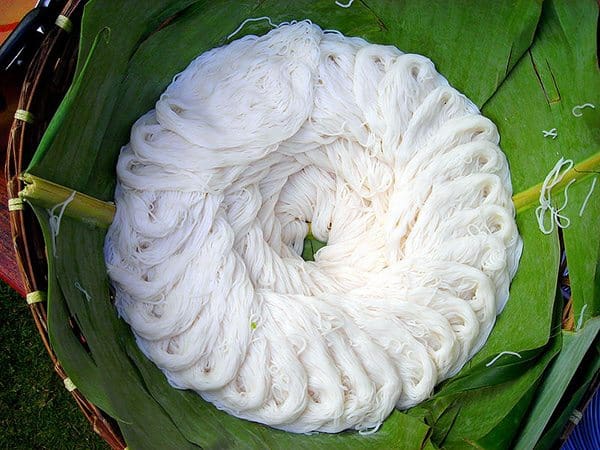
Khanom Jeen
Types of Thai noodle
- Bamee (Chinese egg and wheat flour)
- Sen Yai (wide rice noodles)
- Sen Lek (thin rice noodles)
- Guay Jab (long Chinese noodles)
- Wun Sen (glass/vermicelli noodles)
- Sen Mee (vermicelli rice noodles)
- Giew (wonton)
- Khanom Jeen (fermented rice noodle)
- Giam Ee (rice pin noodles)
- Mee Sua (thin, salty wheat noodles)
Dipping Sauces and Pastes
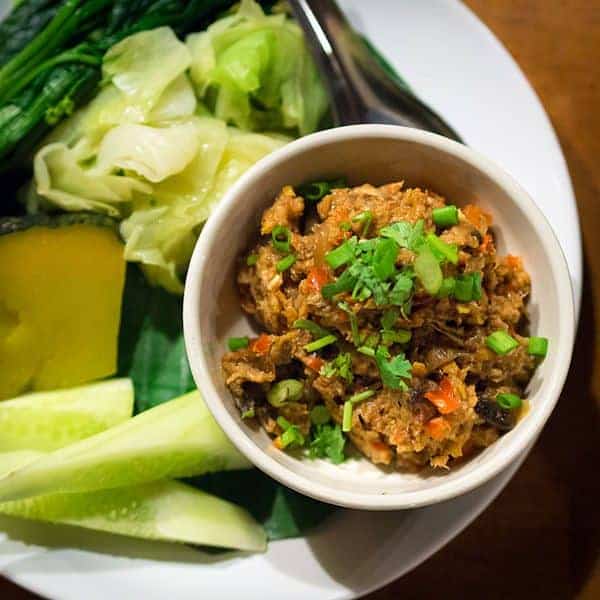
Nam Phrik (By Takeaway: Creative Commons)
Most Thai dishes and buffets will be served up with a small dish of dipping sauce. The exact sauce might vary depending on the particular dish or regional cuisine but there are a few served time and time again.
- Phrik Nam Pla (very popular with rice and noodle dishes — fish sauce with lime and chillies)
- Nam Chim Gai (chilli chicken sauce)
- Nam Chim Chaeo (sweet and spicy — fish sauce, palm sugar, lime, dried chillies and sticky rice)
- Peanut Sauce (to accompany satay)
- Nam Phrik (a northern chilli paste that comes in various adaptations: such as with shrimp paste and dried shrimp (Kapi), with galangal (Kha), with deep-friend pork rinds and garlic (Khaep Moo), with minced pork and tomato (Ong), with large green chillies, shallots and coriander (Num) and with salted egg and sweet pork (Long Ruea))
- Sot Siracha (hot sauce)
Shopping List
It should be clear from the huge variety of dishes, sauces and starches, that Thai cuisine is very heavy on ingredients. As David Thompson said, simplicity this ain’t.
If you’re planning on stocking a Thai kitchen, here are some of the major items that should be on your shopping list:
Fresh:
- Chillies (particularly bird eye, red and dried)
- Thai holy basil
- Coriander
- Palm sugar
- Lemongrass
- Kaffir lime leaves
- Galangal
- Turmeric
- Shallots
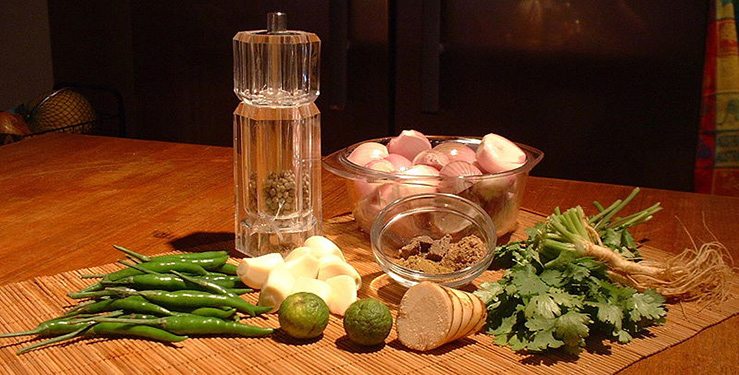
By FotoosVanRobin (Creative Commons)
For the pantry:
- Jasmine rice
- Sticky rice
- Rice noodles
- Tamarind pulp or liquid
- Dried shrimp
- Fish sauce
- Shrimp paste
- Coconut milk
- White peppercorns
- Star Anise
- Soy sauce
- Oyster sauce
- Sriracha sauce
Best Thai Food Blogs
If you’re keen to get into the kitchen and put your newfound (or refreshed) knowledge to use, it’s a great idea to seek inspiration from the Thai chefs and bloggers who are doing the experimentation for you.
Thai food bloggers are almost two-a-penny, but there a few who easily stand out from the crowd:
- She Simmers — our favourite Thai cookery blog, who has an impressive back catalogue of traditional recipes and experimental dishes, accompanied by gorgeous photos and personal insight. A great read.
- Bangkok Glutton — this is a more ‘talking about Thai food’ blog, where the author conveys her passion for the cuisine through essays on Thai concepts, restaurant reviews and more. Really insightful and entertaining.
- Thai Foodie — an American blogger completely in love with Thai food who exchanges her culinary tips and tricks, recipes and even the personal life of her half Thai/half American family.
What’s your favourite Thai dish?
Featured image includes a photo by Magalie L’Abbé and is used under a Creative Commons licence

